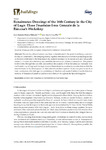Renaissance Drawings of the 16th Century in the City of Lugo: Three Fountains from Gonzalo de la Bárcena’s Workshop

Ver/
Use este enlace para citar
http://hdl.handle.net/2183/20764
A non ser que se indique outra cousa, a licenza do ítem descríbese como Atribución 4.0 Internacional
Coleccións
- Investigacion (ETSAC) [511]
Metadatos
Mostrar o rexistro completo do ítemTítulo
Renaissance Drawings of the 16th Century in the City of Lugo: Three Fountains from Gonzalo de la Bárcena’s WorkshopData
2018-03-16Cita bibliográfica
Franco Taboada, J.A.; Goy Diz, A.E. Renaissance Drawings of the 16th Century in the City of Lugo: Three Fountains from Gonzalo de la Bárcena’s Workshop. Buildings 2018, 8, 44.
Resumo
[Abstract] Historically, urban fountains have been underestimated to the point of not being considered worthy of conservation. The foregoing reason, together with the lack of sufficient archaeological data on this type of element in the Renaissance city, makes it necessary to document and carry out graphic research to correct this deficiency and establish the relevance of these constructions. The present work shows, through the concrete case method, the analysis of three Renaissance fountains from the Spanish city of Lugo and the importance of these elements as urban landmarks that marked the essential lines of the development of cities after the medieval period. It also analyses the work of their constructors, who belonged to a workshop of plumbers and master builders from the historical territory of Trasmiera (Cantabria) and who took their art throughout the Spanish kingdom
Palabras chave
Architecture
Renaissance
Representation
Fountains
Lugo
Galicia
Renaissance
Representation
Fountains
Lugo
Galicia
Versión do editor
Dereitos
Atribución 4.0 Internacional
ISSN
2075-5309






